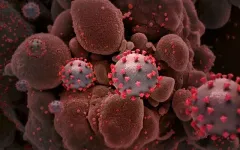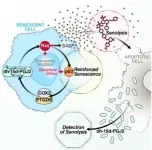Novel cancer vaccine targets oncogenes known to evade immunity in melanoma and neuroblastoma models
2021-04-02
(Press-News.org) A personalized tumor cell vaccine strategy targeting Myc oncogenes combined with checkpoint therapy creates an effective immune response that bypasses antigen selection and immune privilege, according to a pre-clinical study for neuroblastoma and melanoma. The neuroblastoma model showed a 75% cure with long-term survival, researchers at Children's National Hospital found.
Myc is a family of regulator genes and proto-oncogenes that help manage cell growth and differentiation in the body. When Myc mutates to an oncogene, it can promote cancer cell growth. The Myc oncogenes are deregulated in 70% of all human cancers.
Myc mutations, like the amplification of c-MYC and MYCN, are associated with host immune suppression in melanoma and neuroblastoma tumors, according to the study published in The Journal for Immunotherapy of Cancer.
"Paradoxically, from an immunotherapeutic perspective, a lack of an immune response may offer an opportunity to target those tumors [melanoma and neuroblastoma] that would be less resistant to host immunity assuming potent cellular immunity can be generated against the tumor," said Wu et al.
The findings suggest that small molecule inhibitors--I-BET726 and JQ1--suppress Myc's uncontrolled cellular proliferation and enhance the immune response against tumor cells themselves, enabling their use as a tumor cell vaccine. The combination of cell vaccine and available therapies that keep the immune responses in check, also known as checkpoint inhibitor therapy, can help inform a personalized therapeutic tumor vaccine in the future.
"The work is pre-clinical and although we have seen excellent responses in these models, we need to determine whether this will also be effective in humans," said Xiaofang Wu, staff scientist III at Sheikh Zayed Institute for Pediatric Surgical Innovation and lead author. "For this purpose we have started laboratory testing in human cells. Our eventual hope is to translate these basic science findings to clinical application."
There is a need for more effective therapies for neuroblastoma and melanoma, given the poor outcome of patients experiencing high-risk or advanced disease through traditional chemotherapy methods. While the field has developed tumor vaccines and immune-based therapies, c-MYC and MYCN seem to protect the tumor against an immune response, so they often evade cure.
The researchers cautioned that both models induced potent immunity but draw different results, which means that this novel therapeutic vaccine is more effective in the mouse neuroblastoma model than in the melanoma model. The neuroblastoma model resulted in a remarkable 75% cure and significantly improved long-term survival despite a larger initial tumor challenge.
"In contrast, the melanoma tumor gained adaptive resistance that is associated with an imbalance between tumor cell growth and cytotoxic killing and thus the vaccine failed to eradicate the tumor," said Wu et al. "Despite potent immune effects from the vaccine, other immunosuppressive molecules will need to be targeted to see the full effects of the vaccine protocol in the melanoma model."
The study proposes a framework that could be translated for therapeutic patient-specific vaccines for MYCN-amplified neuroblastoma tumors resistant to available therapies.
To understand the exact role of c-Myc and MYCN amplification and their association with immune suppression, the researchers examined 21 human neuroblastoma samples--the majority with metastatic disease--and 324 melanoma samples where only 30 were categorized as MYC amplified. Based on the oncogene's capability to suppress the immune response, the researchers combined checkpoint inhibitors with pharmacologic molecules--I-BET726 and JQ1--to target Myc oncogenes in mouse neuroblastoma and melanoma models. They also tested for the effects of different doses, drug combinations and incubation times on tumor cell proliferation, differentiation and gene alteration.
INFORMATION:
ELSE PRESS RELEASES FROM THIS DATE:
2021-04-02
James McKerrow, MD, PhD, dean of the Skaggs School of Pharmacy and Pharmaceutical Sciences at University of California San Diego, has long studied neglected tropical diseases -- chronic and disabling parasitic infections that primarily affect poor and underserved communities in developing nations. They're called "neglected" because there is little financial incentive for pharmaceutical companies to develop therapies for them.
One of these neglected diseases is Chagas disease, the leading cause of heart failure in Latin America, which is spread by "kissing bugs" carrying the parasite Trypanosoma cruzi. These parasites produce an enzyme called cruzain that helps ...
2021-04-02
A novel mechanism has been identified that might explain why a rare mutation is associated with familial Alzheimer's disease in a new study by investigators at the University of Chicago. The paper, published on April 2 in the Journal of Experimental Medicine, characterizes a mutation located in a genetic region that was not previously thought be pathogenic, upending assumptions about what kinds of mutations can be associated with Alzheimer's Disease.
Alzheimer's, a neurodegenerative disease that currently affects more than 6 million Americans, has ...
2021-04-02
Buck Institute researchers have discovered and are developing a novel, non-invasive biomarker test that can be used to measure and track performance of senolytics: a class of drugs that selectively eliminate senescent cells. The discovery is expected to play a major role in efforts to develop treatments that would battle a myriad of chronic age-related conditions that range from arthritis to lung disease to Alzheimer's disease and glaucoma. This biomarker is a unique signaling lipid metabolite, normally exclusively intracellular, but is released when senescent cells are forced to die. This metabolite is detectible in blood and urine, making non-invasive ...
2021-04-02
Gasoline, the primary transportation fuel, contains hydrocarbons with 5-11 carbons (C5-11) and is almost derived from petroleum at present.
Gasoline can also be produced from non-petroleum syngas. Nonetheless, achieving high conversions of syngas to C5-11 with excellent selectivity and stability remains a challenge.
A research group led by Prof. LIU Zhongmin and Prof. ZHU Wenliang from the Dalian Institute of Chemical Physics (DICP) of the Chinese Academy of Sciences realized highly efficient and selective conversion of syngas to gasoline-range liquid hydrocarbons over a dual-bed catalyst.
The study was published in Chem Catalysis on April 2.
This dual-bed catalyst, (CZA +Al2O3)/N-ZSM-5(97), consists ...
2021-04-02
Up to one in five employees at an academic medical institution are considering leaving their professions due to the strains of coping with the pandemic in their own lives, according to a new University of Utah Health study. Individuals who had caregiving responsibilities were among those most likely to contemplate leaving or reducing hours.
The findings suggest that retaining highly trained doctors, nurses, and scientists in the aftermath of the COVID-19 pandemic could be the next great health care challenge.
"It's sobering to learn that, during a time of economic recession, at least one-fifth of our workforce were considering leaving their jobs because of the severe levels of stress they were experiencing," says Angela Fagerlin, Ph.D., the study's senior author and professor ...
2021-04-02
SAN FRANCISCO, CA (April 2, 2021) -- In recent years, advancements in DNA sequencing have exposed a large amount of hidden diversity in reef-building corals: species that appear identical to one another but are genetically distinct. Typically ignored as they are invisible to the naked eye, a team of researchers at the California Academy of Sciences and The University of Queensland, along with over a dozen international collaborators, is taking a more holistic approach to understand these hidden species by investigating overlooked ecological differences that have wide-ranging implications for the vulnerability and resilience of reef-building corals. The team hopes that their findings, ...
2021-04-02
What The Study Did: This survey study examined the career development, productivity, childcare needs and likelihood of leaving the workforce among employees at an academic medical center during the COVID-19 pandemic.
Authors: Angela Fagerlin, Ph.D., of the University of Utah in Salt Lake City, is the corresponding author.
To access the embargoed study: Visit our For The Media website at this link https://media.jamanetwork.com/
(doi:10.1001/jamanetworkopen.2021.3997)
Editor's Note: The article includes conflicts of interest and funding/support disclosures. Please see the article for additional information, including other authors, author contributions and affiliations, conflict of interest and financial disclosures, and funding ...
2021-04-02
What The Study Did: Researchers compared rates of health maintenance organization (HMO) enrollment, by race and ethnicity, for children with commercial and public coverage with the use of national survey data.
Authors: Alon Peltz, M.D., M.B.A., M.H.S., of Harvard Medical School in Boston, is the corresponding author.
To access the embargoed study: Visit our For The Media website at this link https://media.jamanetwork.com/
(doi:10.1001/jamanetworkopen.2021.4162)
Editor's Note: The article includes conflicts of interest and funding/support disclosures. Please see the article for additional ...
2021-04-02
Extended surges in the South and West in the summer and early winter of 2020 resulted in regional increases in excess death rates, both from COVID-19 and from other causes, a 50-state analysis of excess death trends has found. Virginia Commonwealth University researchers' latest study notes that Black Americans had the highest excess death rates per capita of any racial or ethnic group in 2020.
The research, publishing Friday in the Journal of the American Medical Association, offers new data from the last 10 months of 2020 on how many Americans died during 2020 as a result of the effects of the pandemic -- beyond the number of COVID-19 deaths alone -- and which states and racial groups were hit hardest.
The rate of excess deaths -- or deaths above the number that ...
2021-04-02
More than 60% of U.S. adults who vape are interested in quitting, according to a study published today in JAMA Network Open by MUSC Hollings Cancer Center researchers. And among those who vape to help them to quit smoking, some are successful while others continue smoking and using electronic cigarettes.
The study, which analyzed longitudinal survey data from more than 30,000 adults across the country, aimed to provide the most up-to-date estimate of how many Americans are interested in stopping their use of e-cigarettes or have made past attempts to quit.
According to the findings, former cigarette smokers had the highest intentions and interest in quitting. This is likely due to an increasing number of smokers using e-cigarettes to transition away from cigarettes, said the study's authors.
While ...
LAST 30 PRESS RELEASES:
[Press-News.org] Novel cancer vaccine targets oncogenes known to evade immunity in melanoma and neuroblastoma models





